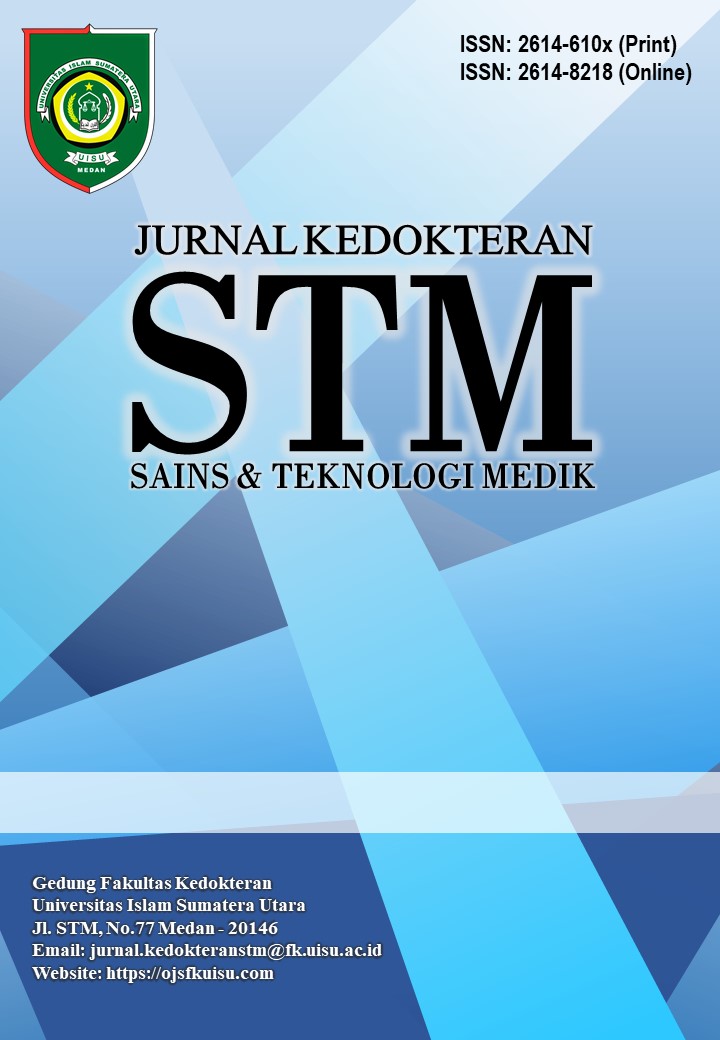HUBUNGAN EKSPRESI PD-L1 DAN DENSITAS TILS PADA SUBTIPE KARSINOMA OVARIUM
CORRELATION OF PD-L1 EXPRESSION AND TILS DENSITY IN OVARIAN CARCINOMA SUBTYPES
Abstract
Background: PD-L1 and tumor-infiltrating lymphocytes (TILs) are essential components of the tumor microenvironment, playing key roles in modulating immune responses against ovarian carcinoma. However, the relationship between these two markers remains underexplored, especially across different histopathological subtypes
Methods: A cross-sectional analytical study was conducted on 40 ovarian carcinoma cases using immunohistochemistry. PD-L1 expression and TIL density were evaluated in both intratumoral and stromal compartments. The Somers’ D test was used to analyze the correlation between variables.
Results: Most patients were aged 40–50 years and presented with stage I disease. The predominant histopathological subtype was serous carcinoma. Intratumoral and stromal TIL densities were mostly low (77.5% and 72.5%, respectively). Positive intratumoral PD-L1 expression was observed in only 5% of cases, while no stromal PD-L1 expression was detected. No statistically significant correlation was found between PD-L1 expression and TIL density, either overall or by subtype.
Conclusion: No significant correlation was observed between PD-L1 expression and TIL density in ovarian carcinoma subtypes. The variability in their expression suggests immune microenvironment heterogeneity, supporting the need for separate evaluation of these biomarkers and individualized approaches to immunotherapy.
Abstrak
Latar Belakang: PD-L1 dan TILs merupakan komponen utama dalam mikrolingkungan tumor yang berperan penting dalam regulasi respons imun terhadap karsinoma ovarium. Hubungan antara keduanya masih jarang dikaji, khususnya pada berbagai subtipe histopatologi.
Tujuan: Menilai hubungan antara ekspresi PD-L1 dan densitas TILs pada beberapa subtipe karsinoma ovarium.
Metode: Penelitian cross-sectional analitik pada 40 kasus karsinoma ovarium menggunakan pewarnaan imunohistokimia. Ekspresi PD-L1 dan densitas TILs dianalisis pada area intratumoral dan stromal. Uji korelasi Somers’ D digunakan untuk menilai hubungan antar variabel.
Hasil: Mayoritas pasien berusia 40–50 tahun dan berada pada stadium klinis I, dengan subtipe terbanyak adalah serous carcinoma. Densitas TILs intratumoral dan stromal sebagian besar tergolong rendah (77,5% dan 72,5%). Ekspresi PD-L1 intratumoral positif ditemukan pada 5% kasus, sedangkan ekspresi PD-L1 stromal tidak ditemukan. Tidak terdapat hubungan yang bermakna antara ekspresi PD-L1 dan densitas TILs, baik secara keseluruhan maupun berdasarkan subtipe.
Kesimpulan:Tidak ditemukan korelasi signifikan antara ekspresi PD-L1 dan densitas TILs pada subtipe karsinoma ovarium. Variasi pola ekspresi antar subtipe mencerminkan heterogenitas imun tumor, sehingga diperlukan evaluasi terpisah PD-L1 dan TILs sebagai biomarker serta pendekatan individualisasi dalam terapi imun.
References
Bray F, Ferlay J, Soerjomataram I, Siegel RL, Torre LA, Jemal A. Global cancer statistics 2018: GLOBOCAN estimates of incidence and mortality worldwide for 36 cancers in 185 countries. CA Cancer J Clin. 2018;68(6):394–424. DOI: 10.3322/caac.21492
Sung H, Ferlay J, Siegel RL, Laversanne M, Soerjomataram I, Jemal A, et al. Global cancer statistics 2020: GLOBOCAN estimates of incidence and mortality worldwide for 36 cancers in 185 countries. CA Cancer J Clin. 2021;71(3):209–49. DOI: 10.3322/caac.21660
WHO Classification of Tumours Editorial Board. Female Genital Tumours. 5th ed. Lyon: IARC; 2020.
Webb JR, Milne K, Kroeger DR, Nelson BH. PD-L1 expression is associated with tumor-infiltrating T cells and favorable prognosis in high-grade serous ovarian cancer. Gynecol Oncol. 2016;141(2):293–302. DOI: 10.1016/j.ygyno.2016.03.008
Gooden MJM, de Bock GH, Leffers N, Daemen T, Nijman HW. The prognostic influence of tumor-infiltrating lymphocytes in cancer: a systematic review with meta-analysis. Br J Cancer. 2011;105(1):93–103. DOI: 10.1038/bjc.2011.189
Hamanishi J, Mandai M, Ikeda T, Minami M, Kawaguchi A, Murayama T, et al. Safety and antitumor activity of anti-PD-1 antibody, nivolumab, in patients with platinum-resistant ovarian cancer. J Clin Oncol. 2015;33(34):4015–22.
DOI: 10.1200/JCO.2015.62.3397
Matulonis UA, Shapira-Frommer R, Santin AD, Lisyanskaya A, Pignata S, Vergote I, et al. Antitumor activity and safety of pembrolizumab in patients with advanced recurrent ovarian cancer: Results from the phase II KEYNOTE-100 study. Ann Oncol. 2019;30(7):1080–7. DOI: 10.1093/annonc/mdz135
Valencia, Asri A, Nizar RZ. Hubungan Ekspresi PD-L1 dengan Derajat Diferensiasi dan Densitas Til di Stroma pada Karsinoma Ovarium Serosum. Patologi Anatomi Universitas Andalas.Padang,Indonesia.2023.https://jurnal.unbrah.ac.id/index.php/heme/issue/view/48
Zhang L, Conejo-Garcia JR, Katsaros D, Gimotty PA, Massobrio M, Regnani G, et al. Intratumoral T cells, recurrence, and survival in epithelial ovarian cancer. N Engl J Med. 2003;348(3):203–13. DOI: 10.1056/NEJMoa020177
The Cancer Genome Atlas Research Network. Integrated genomic analyses of ovarian carcinoma. Nature. 2011;474(7353):609–15. DOI: 10.1038/nature10166
Kim, K.H., Choi, K.U., Kim, A. et al. PD-L1 expression on stromal tumor-infiltrating lymphocytes is a favorable prognostic factor in ovarian serous carcinoma. J Ovarian Res 12, 56 (2019). https://doi.org/10.1186/s13048-019-0526-0.
Li Y, Wang J, Li X, et al. Prognostic significance of PD-1 and PD-L1 expression in colorectal cancer: A meta-analysis. Int J Colorectal Dis. 2020;35(3):375–86. DOI: 10.1007/s00384-020-03734-4
Yano M, Katoh T, Ogasawara A, et al. (2023). 66P PD-L1 expression following neoadjuvant chemotherapy is upregulated and serves as a prognostic factor in patients with advanced high-grade serous ovarian carcinoma. ESMO open, 8(1):100846-100846. DOI: 10.1016/j.esmoop.2023.100846
Chang CH, Chang AC, Shih CC, et al. The prognostic significance of PD1 and PDL1 gene expression in lung cancer: a meta-analysis. Front Oncol. 2021; 11:759497. DOI:10.3389/fonc.2021.
Patel SP, Kurzrock R. PD-L1 expression as a predictive biomarker in cancer immunotherapy. Mol Cancer Ther. 2015;14(4):847–56. DOI: 10.1158/1535-7163.MCT-14-0983
Allison JP, Honjo T. Nobel Lecture: Discovery of immune checkpoint therapy for cancer. NobelPrize.org. 2018. DOI: 10.1016/j.gendis.2018.10.003
Hwang, W.T., Adams, S.F., Coukos, G, et al. Prognostic significance of tumor-infiltrating T cells in ovarian cancer: A meta-analysis. Gynecol. Oncol. 2012, 124, 192–198. DOI: 10.1016/j.ygyno.2011.09.039.
Zhang L, Conejo-Garcia JR, Katsaros D, Gimotty PA, Massobrio M, Regnani G, et al. Intratumoral T cells, recurrence, and survival in epithelial ovarian cancer. N Engl J Med. 2003;348(3):203-13. DOI: 10.1056/NEJMoa020177.
Fridman WH, Pagès F, Sautès-Fridman C, Galon J. The immune contexture in human tumours: impact on clinical outcome. Nat Rev Cancer. 2012;12(4):298–306. DOI: 10.1038/nrc3245
Tumeh PC, Harview CL, Yearley JH, et al. PD-1 blockade induces responses by inhibiting adaptive immune resistance. Nature. 2014;515(7528):568–71. DOI: 10.1038/nature13954
Copyright (c) 2025 Sayed Muhammad Kadri

This work is licensed under a Creative Commons Attribution-ShareAlike 4.0 International License.



